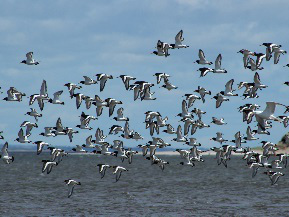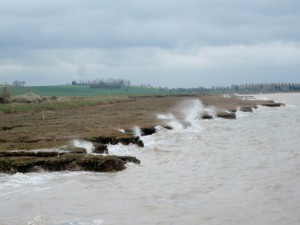What is a salt marsh?
Marshes are usually found in estuaries, which is where a river meets the sea and are rich in wildlife. Birds feed or roost on marshes and fish and crustaceans move in and out with the tide.
Salt marshes form in areas where waves and currents are not too strong. Mud or sand flats are the foundations of a salt marsh. Over time, mud/sand flats are colonised by microscopic and visible algae, which makes the sediment move less. When a mud/sand flat is stable enough and has enough nutrients, saltmarsh plants can begin to grow and a salt marsh is formed.
The water in estuaries is known as brackish: a mixture of fresh water from rivers and salty sea water. Plants and animals that live in estuaries are adapted to brackish water. Many different plants and animals make mud/sand flats and salt marshes their home and are flooded regularly by the sea.
Why are salt marshes important?
Wildlife
Biofilms (that include diatoms, a type of algae) found on mud and sand flats provide food for animals that live in the mud/sand; like worms, snails and shrimp. These animals are an important food source for fish and wading birds like Curlews and Oystercatchers. Mud/sand flats also provide a safe nursery ground for young fish which provides food for birds like the Little Egret.
On the salt marsh, plants are specially adapted to living in a salty environment like Sea Purslane and Common Glasswort. These plants provide important habitat (where plants and animals live) for many invertebrates (animals without a backbone) like the Saltmarsh Wolf Spider and the Blue Tinted’ Ground Beetle which provide food for birds like the Meadow Pipit. Saltmarsh plants also provide food for many birds like Skylarks and Brent Geese.
People
We live, work and play on the coast and we benefit greatly from estuaries:
- Recreation: people enjoy spending time on estuaries; bird watching, walking, camping, wild fowling, sailing etc.
- Food: mud/sand flats are important areas for fish to spawn and raise their young and feed. Salt marshes are used to graze cattle and sheep.
- Nutrient cycling: the nutrients that saltmarsh plants need to grow comes from the land and the sea. The incoming tide brings nutrients to the plants and in turn the plants provide organic matter to the marine food chain.
- Flood defence: salt marshes act as a very effective defence against waves. They absorb wave energy reducing the height of waves thereby reducing the risk of flooding and erosion.














